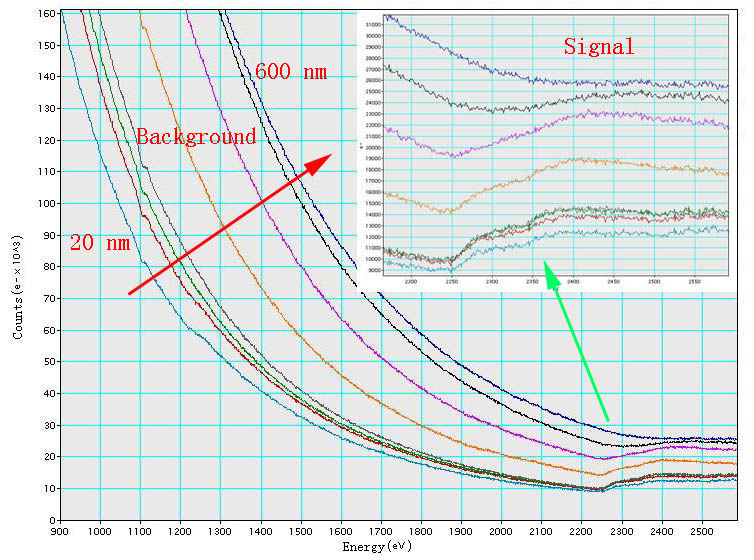Sample Thickness Determination using EELS - Practical Electron Microscopy and Database - - An Online Book - |
||||||||||||||||||||||||||||||||||||||||||
| Microanalysis | EM Book http://www.globalsino.com/EM/ | ||||||||||||||||||||||||||||||||||||||||||
As we know that in TEM observation, the transmission of unscattered incident electrons is inversely proportional to the TEM specimen thickness. On the other hand, the increase of the specimen thickness enhances the energy loss of the transmitted electrons. Therefore, the spatial resolution degrades with the increase of specimen thickness because of the chromatic aberration effects. Table 4621a lists examples of the energy loss of incident electrons passing through the specimen. The use of thinner specimen can generally improve spatial resolution because it minimizes the energy loss. Table 4621a. Examples of the energy loss of electrons passing through the TEM specimen.
For many solids, especially metals, the bonding electrons can be considered as a free electron gas. Plasmons that are oscillations of the free electrons are generated when an incident electron travels through the gas. Plasmon spectra are routinely used to measure the thickness of a TEM specimen because more plasmons are excited as the electron goes through a thicker specimen. If diffraction effects are negligible, thickness t of TEM samples can be evaluated as a multiple of the inelastic mean free path using log-ratio
method [1, 10-11]: The cross-section of the scattering can be extracted by the relation, The mean free inelastic path of electrons ( λ) has to be measured or calculated by an independent method. In practice, It can be replaced by Ip, which is the integral of the low-loss spectrum (e.g. between −3 and 97 eV). This calculation process can be performed with some software, for instance, Gatan digital micrograph (DM). Note that an appropriately modified form of the relationship in Equation 4621a should be applied if the plural scattering has been removed from the spectrum. For the case of EFTEM, similar to Equation 4621a, two intensity maps are acquired: one is formed by all transmitted electrons (intensity It , unfiltered image), the other one by selecting only those electrons that did not lose any energy (intensity I0, filtered image). The relative drift between the unfiltered and filtered images was corrected by a standard cross-correlation technique when computing the ratio map It /I0. Furthermore, to accurately evaluate TEM specimen thicknesses, both surface and bulk plasmons need to be considered. However, in calculations, we normally consider that only the bulk effect contributes to the plasmon-loss in specimens thicker than 150 nm. The surface plasmon-loss (Is) has dependence on TEM-specimen thickness only when the specimen is extremely thin (e.g. <10 nm in general). On the other hand, for very thin TEM specimens, e.g. ≤30 nm for Si (or ≤0.25 λP), several surface-induced effects contribute to plasmon signal: The peak-to-background ratio in EELS varies with specimen thickness so that it also can be used to determine the specimen thickness. For instance, Figure 4621a shows that the background increases dramatically with increase of the thickness of TEM specimen, while the signal of Pt M4,5 edge decreases significantly. In this case, the highest signal in the range of these TEM specimen thicknesses for Pt occurs at 20 nm. However, in the method with peak-to-background ratio, a correlation curve between the ratio and thickness should be plotted and used to calibrate the interesting thickness.
Figure 4621a. EELS of Pt M4,5 edge. Furthermore, the "local" EELS intensity also depends on the spatial resolution of STEM, which is especially important for measurements of multi-layers. It is necessary to mention that the spatial resolution of the measurements in STEM mode can be estimated by the diameter of the probe irradiation on the specimen, given by (see Figure 4621b):
For instance, Figure 4621c shows the spatial resolutions at convergence semiangles 7 and 15 mrad, respectively, based on Equation 4621d. Note that such convergence semiangles are used in many TEM systems.
[1] Egerton, R.F. (1996). Electron Energy Loss Spectroscopy in the
Electron Microscope. New York: Plenum Press.
|
|
|||||||||||||||||||||||||||||||||||||||||
